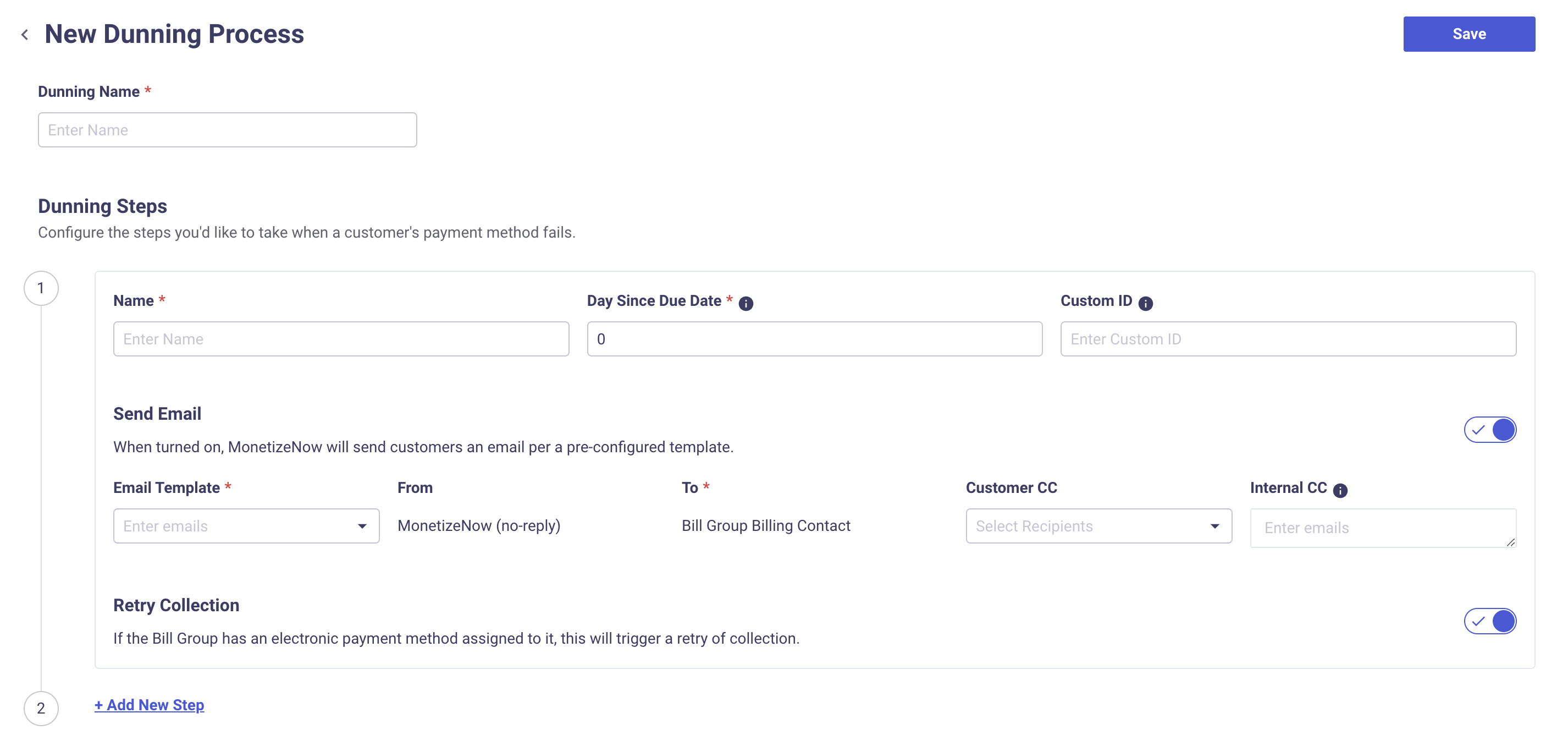Dunning
What is Dunning?
Dunning is the process of communicating with customers to improve the rate of payment against outstanding and overdue Invoices. In the old days, this used to follow a process, MonetizeNow allows you to automate your Dunning process.
How does Dunning work in MonetizeNow?
Dunning is applied to Bill Groups rather than Invoices to ensure that your customers aren't overwhelmed with excessive emails if multiple Invoices are unpaid on the same Bill Group.
MonetizeNow allows you to define any number of Dunning processes. Each Dunning process can have any number of steps. Each step is defined by the Bill Group's number of days since due.
Each step may include sending an email and/or retrying collection of funds from on file payment methods.

How are Dunning processes assigned to newly created Bill Groups
New Bill Groups are assigned a Dunning process as follows:
- If the Account has a
Default Dunning Process, newly created Bill Groups on that Account will be assigned that Dunning process - If the Account does not have a
Default Dunning Processand the tenant does have a default Dunning Process, the new Bill Group will be assigned the tenant default Dunning Process (see FAQ on how this is set) - If not 1 or 2, no Dunning Process is assigned to the newly created Bill Group.
Best practice tips
Keep everyone informed throughout Dunning process
Dunning processes tend to be more successful if your team is aware of each step of the process as it is happening. How do you do it?
- Create a field on your CRM's Account object that will hold a comma-delimited list of emails to receive Dunning notifications. Here's a video walkthrough of how to do this in Salesforce CRM:
- Map that field to the
Account-level CCsfield on MonetizeNow Account using Salesforce Field Mapping or Hubspot Field Mapping. - Select
Account-level CCsas a recipient in Customer CC dropdown when setting up your Dunning process.
Tailor your Dunning process to your varying customers automatically
Organizations with a diverse set of customers often want a Dunning process tailored to their individual needs. The most common factors tend to be company size and ACV. For larger companies and larger ACV, Dunning processes are typically more personalized and less automated.
How do you do it?
- Create a field on your CRM's Account object called
Default Dunning Process ID - Populate that field with a formula or workflow that populates the desired MonetizeNow Dunning Process ID from the MonetizeNow Dunning settings page
- Map your CRM's
Default Dunning Process IDfield to theDefault Dunning Process IDon MonetizeNow Account field using Salesforce Field Mapping or Hubspot Field Mapping - That's it. Upon Processing a New Quote on that Account, the Bill Group will be assigned the desired Dunning Process.
FAQ
| Question | Answer |
|---|---|
| How do I change / remove the Dunning Process on a Bill Group? | Editing the Bill Group allows for changing / removing the Dunning Process |
| I want to stop Dunning for a specific Bill Group while I negotiate with them? How do I do that? | Edit the Bill Group and remove the Dunning Process |
| How do I add a Dunning Process to a Bill Group? | Edit the Bill Group and add the Dunning Process of your choosing |
| How do I set the default Dunning Process for the Tenant? | When viewing all configured Dunning Processes on the Tenant, you may set one as default. Note: this is optional. See prior question for how this setting is used. |
Updated 11 months ago